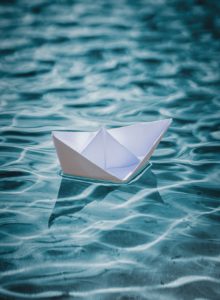 In Submerged Hopes, the hero makes a passing comment regarding learning about ancient naval warfare techniques in the Naval Academy. Here’s what I learned in my research!
In Submerged Hopes, the hero makes a passing comment regarding learning about ancient naval warfare techniques in the Naval Academy. Here’s what I learned in my research!
Sea power was critical in antiquity for the movement of troops, ammunition, food, and fodder, and that alone helped cement the authority of the ancient empires, like the Egyptians, the Phoenicians, Athens, Carthage, and Rome, as well as more recent contenders like Venice, the Vikings, and Great Britain. Over time, naval activities evolved into a combat role, instead of mere transport.
The earliest datable sea battle was in 1210 B.C., when a Hittite king defeated the fleet from Cyprus, though scenes from an Egyptian temple depict a naval ambush and archers, both ashore and from ships, to defeat the “Sea Peoples,” a confederation of enemy nations. Assyrian reliefs show Phoenician warships with double oars, fighting men on a platform, and a ram below the waterline to breach hulls.
The oracle of Delphi’s prediction of “wooden walls” to protect Athens referred to her wooden ships, which were funded by the profits from her silver mines, and her naval supremacy was unparalleled at the time. In 480 B.C. at the Battle of Salamis, the Athenians were able to trap the Persian army in a narrow channel. The enemy sustained losses of 200 ships, to forty of the Athenian fleet. The story is the subject of “The Persians,” the world’s oldest surviving play, which was written only a few years after the battle.
Mobility depended on oarsmen, but to have enough room for many men led to longer and longer ships, which were unwieldy and heavy—no small thing since these softwood ships became waterlogged if left in the ocean. It was typical to ground the fleet at night, with as few as 140 men carrying a ship ashore. This did make them vulnerable to attack, and ancient references to “burning a fleet” generally meant beached ships caught unawares.
To solve the problem of power and maneuverability, designs incorporated double lines of rowers, some deep in the hold and another row on the deck; these ships were called biremes. Over time, triremes became standard, with two rows on men working in the dark, with chants to keep time. These ships could go six knots and cover about fifty miles in an eight-hour day. Later, during the Roman Empire, the massive quinqueremes had five levels of rowers.
The main method of attack was ramming with a bronze-tipped beam below the waterline, though each ship did have ten or twenty marines for archery or hand-to-hand combat. Evasive maneuvers were the first level of defense, and crews were trained to rush to the other side of the boat if a hole was punched in the hull, to try to keep the breach above the waterline and stay afloat. Some ships had a brass band as protection, but this added weight. Thus, Zakynthos Island, which was famous for its waterproofing pitch, was of strategic military importance, and changed hands many times.
Overtime, further refinements in war included a hinged drawbridge called a raven, which caused a spike on the bottom to pierce hulls and also helped board, a dolphin, a huge lead weight with a pointed bottom, which could be dropped from a yardarm through the hull, and “Greek fire.” The only known example of a war dolphin came from the Antikythera Shipwreck northwest of Crete (check out the website if you missed it!).
Greek fire was essentially a flamethrower, either ship-mounted, or held by a single man, used by the Byzantine navy. The exact recipe was a closely-held secret, as was the workings of the machinery, called a siphon, so much that workers were trained on one section of the mechanism and kept ignorant of the rest. The flames spewed out to coat an enemy ship, and floated atop the water. It must have been terrifying; the machines were said to rumble and roar, and the spigot tip was often fashioned into the face of a beast. Greek fire could also be lobbed via flaming pots, and probably was the inspiration for the “wildfire” in Game of Thrones.
The composition has been lost in antiquity but it appears to have contained naphtha (a crude petroleum) and quicklime. The fragments of instructions caution the makers to avoid direct sunshine because of the tendency of the compound to spontaneously combust.
Constantinople was saved by Greek fire during the first and second Arab sieges in 672, and the technology was ascribed to a divine gift. Eventually, the Arabs captured a fireship containing siphons and the compound itself, but were never able to replicate it. Regardless of its offensive capabilities, Greek fire was limited by prevailing winds and its relatively short range. Over time, the Arabs learned simply to stay out of reach, and to cover their ships with vinegar-soaked felt. The Arab Empire became dominant in the Mediterranean from the 7th-13th centuries, during the Islamic Golden Age, and it was during this time that the torpedo was invented in Syria.
Refinements in gunpowder in the late 16th century brought the extensive use of heavy cannons, and the invention of steam power permitted huge ships with heavier weaponry and armor, ushering in the modern age.
Lastly, there is a Greek Fire cocktail recipe, which combines brandy and ouzo. Alas, though it seems it should be served flaming, that’s not the case, but it does burn! Yiamas!
Recent Comments